Saturday, August 22, 2020
National Coherer Day
August 20 was National Radio Day, arbitrarily created in the '70s to celebrate WWJ in Detroit. This year is the centennial of WWJ's first broadcast, which wasn't exactly the first commercial broadcast but close.
I'll arbitrarily call today National Coherer Day because I feel like it.
Coherers were an odd sidetrack in the history of radio. They were developed by experiment and accident, not by theory. Coherers flourished in a very specific environment, and helped to maintain the environment. Spark gap transmitters favored coherer receivers, and coherer receivers favored spark gap transmitters.
Most of all, coherers were strictly for Morse, and strictly for driving a tape-writer or plotter. They didn't belong in a system that relied on human hearing, whether via Morse sounder or earphones. Printers were part of the early transatlantic cable systems, and printers were mature and reliable at the time when wireless experimentation started. Marconi saw wireless as a replacement for the transatlantic cable, with essentially one sender and one receiver; so his system was surrounded and constrained by the analogy and the existing equipment.
= = = = =
Let's start with a complete Lodge-Muirhead station, operated by Polistra with the help of Happystar.
Lodge designed a resonant antenna, with two conical capacitive elements tied by an inductive element.
 The station included, from right to left, the Morse key (hidden by Polistra); the Lodge Buzzer; an induction coil; a spark gap tuned by Leyden jar capacitors and an inductor; the transmit-receive switch leading out to the antenna; a Lodge Coherer; and finally a printer or tape-writer.
The station included, from right to left, the Morse key (hidden by Polistra); the Lodge Buzzer; an induction coil; a spark gap tuned by Leyden jar capacitors and an inductor; the transmit-receive switch leading out to the antenna; a Lodge Coherer; and finally a printer or tape-writer.
 The Lodge Buzzer was an overly complex way of providing AC to the primary of the induction coil. Most systems used a simple hammerbreak. The Buzzer was a three-stage relay, allowing the Morse key to handle low voltage and current. The fast switching of high current for the primary was done by a mercury dip.
The Lodge Buzzer was an overly complex way of providing AC to the primary of the induction coil. Most systems used a simple hammerbreak. The Buzzer was a three-stage relay, allowing the Morse key to handle low voltage and current. The fast switching of high current for the primary was done by a mercury dip.
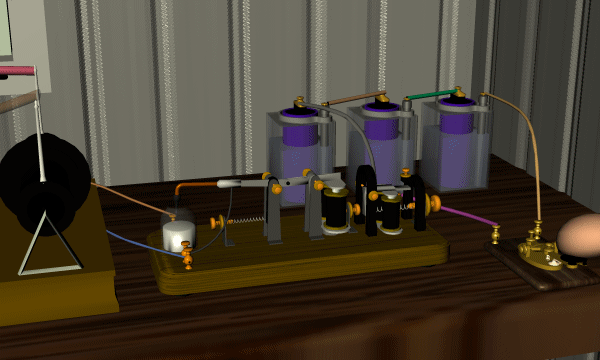 Now we see the whole thing ticking and tapping away, while Polistra sends a meaningful message through the antenna.
Now we see the whole thing ticking and tapping away, while Polistra sends a meaningful message through the antenna.
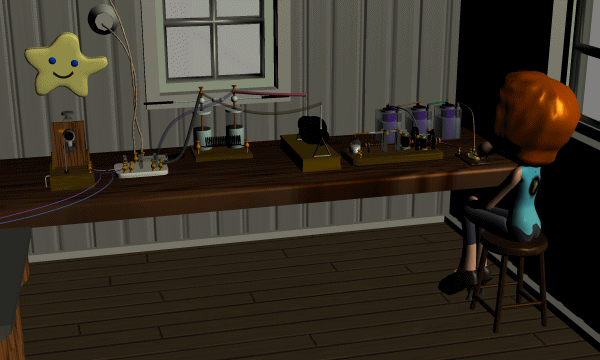 Early telegraph rigs were extremely clocky, with all sorts of mechanical pendulums and escapements, and electrically switched pendulums.
Before looking at the Lodge Disc Coherer, we'll show the most common coherer.
Early telegraph rigs were extremely clocky, with all sorts of mechanical pendulums and escapements, and electrically switched pendulums.
Before looking at the Lodge Disc Coherer, we'll show the most common coherer.
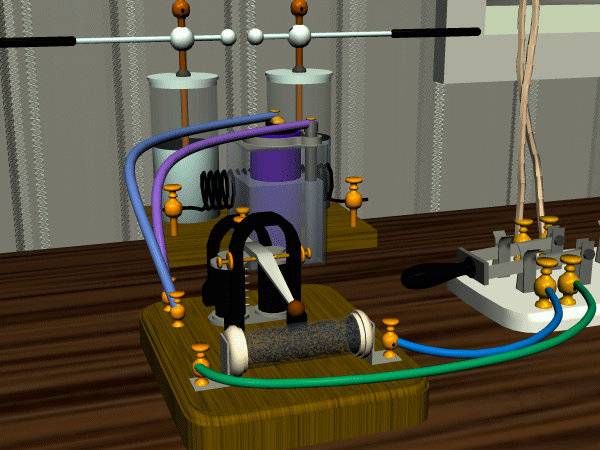 A glass tube with loose metal powder or filings inside. The tube was placed in series with a battery and the printer or tape-writer. Normally the filings had a high resistance, essentially non-conducting. When an RF signal came through the ether near the coherer, or a high-frequency signal was imposed on the DC, the filings lined up and cohered, closing the circuit and effectively acting like a relay. The filings wanted to remain lined up, so a mechanical tapper was needed to break them apart between dots and dashes. This tapper is run by a buzzer, but it could also be pure mechanical clockwork.
The Lodge Disc was entirely different.
A glass tube with loose metal powder or filings inside. The tube was placed in series with a battery and the printer or tape-writer. Normally the filings had a high resistance, essentially non-conducting. When an RF signal came through the ether near the coherer, or a high-frequency signal was imposed on the DC, the filings lined up and cohered, closing the circuit and effectively acting like a relay. The filings wanted to remain lined up, so a mechanical tapper was needed to break them apart between dots and dashes. This tapper is run by a buzzer, but it could also be pure mechanical clockwork.
The Lodge Disc was entirely different.
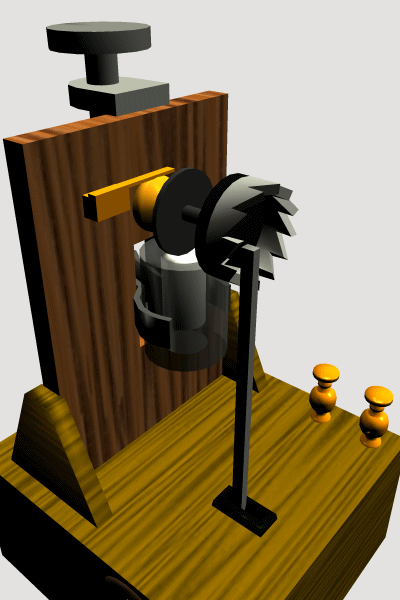 Here's a description of its action:
This is done by causing a small steel disc to revolve continuously in contact with a column of mercury, between which is interposed a thin film of oil. In action the coherer operates as follows: When the impinging waves set up oscillations in the resonator circuit the potential difference due to their cumulative effect disrupts the film of oil and at that instant cohesion takes place between the molecules of the solid and the fluid metals, only to be instantly restored by a partial revolution of the disc.
The thin layer of oil between dissimilar metals was probably acting like a semiconductor, similar to a catwhisker or even a bijunction transistor. "Cumulative" implies that some degree of rectifying was going on.
Marconi tried another variation on the constantly moving surface:
Here's a description of its action:
This is done by causing a small steel disc to revolve continuously in contact with a column of mercury, between which is interposed a thin film of oil. In action the coherer operates as follows: When the impinging waves set up oscillations in the resonator circuit the potential difference due to their cumulative effect disrupts the film of oil and at that instant cohesion takes place between the molecules of the solid and the fluid metals, only to be instantly restored by a partial revolution of the disc.
The thin layer of oil between dissimilar metals was probably acting like a semiconductor, similar to a catwhisker or even a bijunction transistor. "Cumulative" implies that some degree of rectifying was going on.
Marconi tried another variation on the constantly moving surface:
 Looks like a tape recorder or wire recorder. The large-diameter coil around the moving wire carried the DC, and the antenna was connected to the small-diameter coil inside it. When RF was present, the magnetic particles in the wire cohered, strengthening the core effect, raising the inductance of the large coil momentarily, and thus providing a pulse of added current in the larger coil. The moving loop gave this section of wire a chance to relax its coherence before it was used again.
Another inventor went full biological, reverting to Galvani.
Looks like a tape recorder or wire recorder. The large-diameter coil around the moving wire carried the DC, and the antenna was connected to the small-diameter coil inside it. When RF was present, the magnetic particles in the wire cohered, strengthening the core effect, raising the inductance of the large coil momentarily, and thus providing a pulse of added current in the larger coil. The moving loop gave this section of wire a chance to relax its coherence before it was used again.
Another inventor went full biological, reverting to Galvani.
 A frog leg carried a pen in its foot, and the RF was enough to trigger muscular contractions.
= = = = =
An early realization of the need for tuning came close to understanding the principle of rectifiers:
To excite the coherer under the conditions presumed to be necessary for
long distances, the impulses due to these waves must syntonize with the natural period of oscillation of the receiving circuit, and therefore these successive waves must pass by that circuit (wherever it may be), with the second following in the same phase as the first, or nearly so, otherwise the tendency of the second one will be to weaken or annul the effect of the first one.
Again emphasizing the cumulative effect. Almost got the point of rectifying, but not quite. Fleming finally realized that it was necessary to eliminate or invert the negative side of the sine wave. A symmetrical wave adds and subtracts equally, so the sum is zero. Removing one side made it possible to accumulate the RF power, which could then be filtered to sort out the modulation. But the realization was hard to grasp while the sparks and coherers were working together nicely.
= = = = =
Earlier I mentioned an attempt to see coherer-like activity in the brain. The experiments were interesting, and I noted that the connection was actually better than the 1906 researcher could see.
There's a separate coherer-like response in nearly all neurons, which didn't occur to me at that point. A spark-gap signal received by a coherer, complete with the buzzing and tapping and ticking at both ends, was a pulse train of varying length. A longer series of pulses for a dash, shorter series for a dot. This is how MOST neurons communicate and accumulate their signals. Pulse trains of varying lengths.
= = = = =
Happy ending:
Surprisingly, coherers are enjoying a second life in the new digital world.
A frog leg carried a pen in its foot, and the RF was enough to trigger muscular contractions.
= = = = =
An early realization of the need for tuning came close to understanding the principle of rectifiers:
To excite the coherer under the conditions presumed to be necessary for
long distances, the impulses due to these waves must syntonize with the natural period of oscillation of the receiving circuit, and therefore these successive waves must pass by that circuit (wherever it may be), with the second following in the same phase as the first, or nearly so, otherwise the tendency of the second one will be to weaken or annul the effect of the first one.
Again emphasizing the cumulative effect. Almost got the point of rectifying, but not quite. Fleming finally realized that it was necessary to eliminate or invert the negative side of the sine wave. A symmetrical wave adds and subtracts equally, so the sum is zero. Removing one side made it possible to accumulate the RF power, which could then be filtered to sort out the modulation. But the realization was hard to grasp while the sparks and coherers were working together nicely.
= = = = =
Earlier I mentioned an attempt to see coherer-like activity in the brain. The experiments were interesting, and I noted that the connection was actually better than the 1906 researcher could see.
There's a separate coherer-like response in nearly all neurons, which didn't occur to me at that point. A spark-gap signal received by a coherer, complete with the buzzing and tapping and ticking at both ends, was a pulse train of varying length. A longer series of pulses for a dash, shorter series for a dot. This is how MOST neurons communicate and accumulate their signals. Pulse trains of varying lengths.
= = = = =
Happy ending:
Surprisingly, coherers are enjoying a second life in the new digital world.
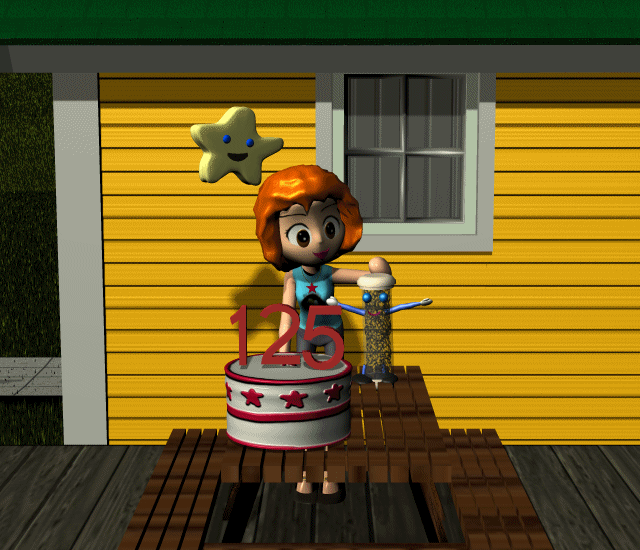 In the '50s, US and Soviet researchers were using coherers as computer memory elements, taking advantage of the natural hold time to create a 'short-term' memory.
Several recent Japanese patents use old-style powder coherers for the original purpose, giving a sensitive relay-like response to small added AC. The patents use coherers in touch-sensitive pens, or to detect nearby lightning.
Convective question: Wouldn't it be nice if our wetware memory had a tapper to break up unwanted coherences? Instant answer: We do have a tapper. Walking. Also, some biofeedbackish therapy techniques use finger tapping for this exact purpose.
= = = = =
Here's the set for Poser at ShareCG.
Followup, a real experiment with a real coherer!
In the '50s, US and Soviet researchers were using coherers as computer memory elements, taking advantage of the natural hold time to create a 'short-term' memory.
Several recent Japanese patents use old-style powder coherers for the original purpose, giving a sensitive relay-like response to small added AC. The patents use coherers in touch-sensitive pens, or to detect nearby lightning.
Convective question: Wouldn't it be nice if our wetware memory had a tapper to break up unwanted coherences? Instant answer: We do have a tapper. Walking. Also, some biofeedbackish therapy techniques use finger tapping for this exact purpose.
= = = = =
Here's the set for Poser at ShareCG.
Followup, a real experiment with a real coherer!
 The station included, from right to left, the Morse key (hidden by Polistra); the Lodge Buzzer; an induction coil; a spark gap tuned by Leyden jar capacitors and an inductor; the transmit-receive switch leading out to the antenna; a Lodge Coherer; and finally a printer or tape-writer.
The station included, from right to left, the Morse key (hidden by Polistra); the Lodge Buzzer; an induction coil; a spark gap tuned by Leyden jar capacitors and an inductor; the transmit-receive switch leading out to the antenna; a Lodge Coherer; and finally a printer or tape-writer.
 The Lodge Buzzer was an overly complex way of providing AC to the primary of the induction coil. Most systems used a simple hammerbreak. The Buzzer was a three-stage relay, allowing the Morse key to handle low voltage and current. The fast switching of high current for the primary was done by a mercury dip.
The Lodge Buzzer was an overly complex way of providing AC to the primary of the induction coil. Most systems used a simple hammerbreak. The Buzzer was a three-stage relay, allowing the Morse key to handle low voltage and current. The fast switching of high current for the primary was done by a mercury dip.
 Now we see the whole thing ticking and tapping away, while Polistra sends a meaningful message through the antenna.
Now we see the whole thing ticking and tapping away, while Polistra sends a meaningful message through the antenna.
 Early telegraph rigs were extremely clocky, with all sorts of mechanical pendulums and escapements, and electrically switched pendulums.
Before looking at the Lodge Disc Coherer, we'll show the most common coherer.
Early telegraph rigs were extremely clocky, with all sorts of mechanical pendulums and escapements, and electrically switched pendulums.
Before looking at the Lodge Disc Coherer, we'll show the most common coherer.
 A glass tube with loose metal powder or filings inside. The tube was placed in series with a battery and the printer or tape-writer. Normally the filings had a high resistance, essentially non-conducting. When an RF signal came through the ether near the coherer, or a high-frequency signal was imposed on the DC, the filings lined up and cohered, closing the circuit and effectively acting like a relay. The filings wanted to remain lined up, so a mechanical tapper was needed to break them apart between dots and dashes. This tapper is run by a buzzer, but it could also be pure mechanical clockwork.
The Lodge Disc was entirely different.
A glass tube with loose metal powder or filings inside. The tube was placed in series with a battery and the printer or tape-writer. Normally the filings had a high resistance, essentially non-conducting. When an RF signal came through the ether near the coherer, or a high-frequency signal was imposed on the DC, the filings lined up and cohered, closing the circuit and effectively acting like a relay. The filings wanted to remain lined up, so a mechanical tapper was needed to break them apart between dots and dashes. This tapper is run by a buzzer, but it could also be pure mechanical clockwork.
The Lodge Disc was entirely different.
 Here's a description of its action:
This is done by causing a small steel disc to revolve continuously in contact with a column of mercury, between which is interposed a thin film of oil. In action the coherer operates as follows: When the impinging waves set up oscillations in the resonator circuit the potential difference due to their cumulative effect disrupts the film of oil and at that instant cohesion takes place between the molecules of the solid and the fluid metals, only to be instantly restored by a partial revolution of the disc.
The thin layer of oil between dissimilar metals was probably acting like a semiconductor, similar to a catwhisker or even a bijunction transistor. "Cumulative" implies that some degree of rectifying was going on.
Marconi tried another variation on the constantly moving surface:
Here's a description of its action:
This is done by causing a small steel disc to revolve continuously in contact with a column of mercury, between which is interposed a thin film of oil. In action the coherer operates as follows: When the impinging waves set up oscillations in the resonator circuit the potential difference due to their cumulative effect disrupts the film of oil and at that instant cohesion takes place between the molecules of the solid and the fluid metals, only to be instantly restored by a partial revolution of the disc.
The thin layer of oil between dissimilar metals was probably acting like a semiconductor, similar to a catwhisker or even a bijunction transistor. "Cumulative" implies that some degree of rectifying was going on.
Marconi tried another variation on the constantly moving surface:
 Looks like a tape recorder or wire recorder. The large-diameter coil around the moving wire carried the DC, and the antenna was connected to the small-diameter coil inside it. When RF was present, the magnetic particles in the wire cohered, strengthening the core effect, raising the inductance of the large coil momentarily, and thus providing a pulse of added current in the larger coil. The moving loop gave this section of wire a chance to relax its coherence before it was used again.
Another inventor went full biological, reverting to Galvani.
Looks like a tape recorder or wire recorder. The large-diameter coil around the moving wire carried the DC, and the antenna was connected to the small-diameter coil inside it. When RF was present, the magnetic particles in the wire cohered, strengthening the core effect, raising the inductance of the large coil momentarily, and thus providing a pulse of added current in the larger coil. The moving loop gave this section of wire a chance to relax its coherence before it was used again.
Another inventor went full biological, reverting to Galvani.
 A frog leg carried a pen in its foot, and the RF was enough to trigger muscular contractions.
= = = = =
An early realization of the need for tuning came close to understanding the principle of rectifiers:
To excite the coherer under the conditions presumed to be necessary for
long distances, the impulses due to these waves must syntonize with the natural period of oscillation of the receiving circuit, and therefore these successive waves must pass by that circuit (wherever it may be), with the second following in the same phase as the first, or nearly so, otherwise the tendency of the second one will be to weaken or annul the effect of the first one.
Again emphasizing the cumulative effect. Almost got the point of rectifying, but not quite. Fleming finally realized that it was necessary to eliminate or invert the negative side of the sine wave. A symmetrical wave adds and subtracts equally, so the sum is zero. Removing one side made it possible to accumulate the RF power, which could then be filtered to sort out the modulation. But the realization was hard to grasp while the sparks and coherers were working together nicely.
= = = = =
Earlier I mentioned an attempt to see coherer-like activity in the brain. The experiments were interesting, and I noted that the connection was actually better than the 1906 researcher could see.
There's a separate coherer-like response in nearly all neurons, which didn't occur to me at that point. A spark-gap signal received by a coherer, complete with the buzzing and tapping and ticking at both ends, was a pulse train of varying length. A longer series of pulses for a dash, shorter series for a dot. This is how MOST neurons communicate and accumulate their signals. Pulse trains of varying lengths.
= = = = =
Happy ending:
Surprisingly, coherers are enjoying a second life in the new digital world.
A frog leg carried a pen in its foot, and the RF was enough to trigger muscular contractions.
= = = = =
An early realization of the need for tuning came close to understanding the principle of rectifiers:
To excite the coherer under the conditions presumed to be necessary for
long distances, the impulses due to these waves must syntonize with the natural period of oscillation of the receiving circuit, and therefore these successive waves must pass by that circuit (wherever it may be), with the second following in the same phase as the first, or nearly so, otherwise the tendency of the second one will be to weaken or annul the effect of the first one.
Again emphasizing the cumulative effect. Almost got the point of rectifying, but not quite. Fleming finally realized that it was necessary to eliminate or invert the negative side of the sine wave. A symmetrical wave adds and subtracts equally, so the sum is zero. Removing one side made it possible to accumulate the RF power, which could then be filtered to sort out the modulation. But the realization was hard to grasp while the sparks and coherers were working together nicely.
= = = = =
Earlier I mentioned an attempt to see coherer-like activity in the brain. The experiments were interesting, and I noted that the connection was actually better than the 1906 researcher could see.
There's a separate coherer-like response in nearly all neurons, which didn't occur to me at that point. A spark-gap signal received by a coherer, complete with the buzzing and tapping and ticking at both ends, was a pulse train of varying length. A longer series of pulses for a dash, shorter series for a dot. This is how MOST neurons communicate and accumulate their signals. Pulse trains of varying lengths.
= = = = =
Happy ending:
Surprisingly, coherers are enjoying a second life in the new digital world.
 In the '50s, US and Soviet researchers were using coherers as computer memory elements, taking advantage of the natural hold time to create a 'short-term' memory.
Several recent Japanese patents use old-style powder coherers for the original purpose, giving a sensitive relay-like response to small added AC. The patents use coherers in touch-sensitive pens, or to detect nearby lightning.
Convective question: Wouldn't it be nice if our wetware memory had a tapper to break up unwanted coherences? Instant answer: We do have a tapper. Walking. Also, some biofeedbackish therapy techniques use finger tapping for this exact purpose.
= = = = =
Here's the set for Poser at ShareCG.
Followup, a real experiment with a real coherer!
In the '50s, US and Soviet researchers were using coherers as computer memory elements, taking advantage of the natural hold time to create a 'short-term' memory.
Several recent Japanese patents use old-style powder coherers for the original purpose, giving a sensitive relay-like response to small added AC. The patents use coherers in touch-sensitive pens, or to detect nearby lightning.
Convective question: Wouldn't it be nice if our wetware memory had a tapper to break up unwanted coherences? Instant answer: We do have a tapper. Walking. Also, some biofeedbackish therapy techniques use finger tapping for this exact purpose.
= = = = =
Here's the set for Poser at ShareCG.
Followup, a real experiment with a real coherer!
Labels: Equipoise, Happy Ending, Lodge, Morsenet of Things, Trinity House
